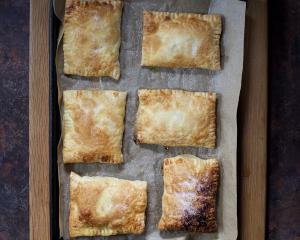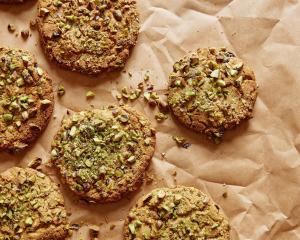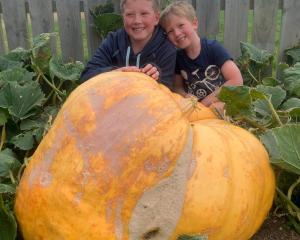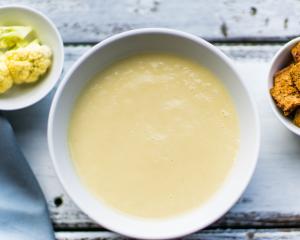The first truly cold days of the year sent me in search of the earthenware gratin dish, the cream and the carbs. I longed for smoked garlic or bacon, soothing starch and puddles of cheese sauce. Food not to excite and inspire but to soothe and cosset. Suddenly, eating is about central heating, bolstering ourselves against the wind and the rain.
I don’t often toss pasta in cream — I find the marriage too soporific — but this week I couldn’t get the idea out of my mind. Pasta shapes with ridges or hollows that would hold a sauce and carry a smoky flavour or two; vegetables that are at their happiest hidden under a blanket of pale, parmesan crusted sauce that’s hot enough to melt the coldest heart.
I upgraded a common or garden cauliflower cheese this week by infusing its ivory sauce with smoked garlic. A savoury note was added with nigella seeds, tiny dots of onion-flavoured crunchiness so perfect I can’t think why I haven’t added them before. A first-class side dish, we ate it as a main, mounds of cream-coloured curds on a pillow of brown basmati I had steamed with a cinnamon stick and sprig of bay leaves.
It is not a necessity that such dinners be frugal in nature, but they often are. Potato or pasta-based suppers rarely break the bank, which is why we can splash out on a tub of cream to serve them with. I made a chicken and pasta recipe whose deep flavour came from deglazing baked-on roasting juices with cream. The dish was made from scratch using cheap, brown thigh meat, but a slightly second-best version could have used the remains of the Sunday roast. ‘‘Second best’’ only in its lack of roasting juices to enrich the sauce. Those would already have been nicked, greedily, for the gravy.
Pasta with roast chicken and pine kernels

Serves 4, generously
4 rosemary sprigs
8 black peppercorns
4 Tbsp olive oil
1kg chicken thighs
pasta, enough pasta for 4, such as fusilli or trofie
7g tarragon
10g parsley
1 lemon
75g pine kernels
500ml cream
Method
Set the oven at 200degC. Pull the leaves from the rosemary then put them in a mortar with the black peppercorns and 1 tsp of sea salt. Grind to a coarse powder then blend in the olive oil.
Put the chicken, skin side down, in a roasting dish, pour over the herbed oil and turn to evenly coat. Roast for 35 to 40 minutes until the skin is crisp and golden.
Bring a deep pot of water to the boil and salt it generously. Remove the chicken from the oven and leave it to rest for 10 minutes, then remove the meat from the bones. Take care to preserve as many of the juices as possible. Tear the chicken into large pieces.
Cook the pasta in the boiling water for around 9 minutes. While it’s cooking, pull the tarragon and parsley leaves from their stems and roughly chop. Zest the lemon and add to the herbs. Toast the pine kernels in a shallow pan for a few minutes until golden then toss them in, too.
Drain the pasta. Place the roasting dish over a moderate heat and pour in the cream, stirring to dissolve any caramelised roasting juices. Add the chicken and pasta, transfer to a warm serving dish, scatter over the tarragon crumbs and serve.
Cauliflower with cheddar and smoked garlic
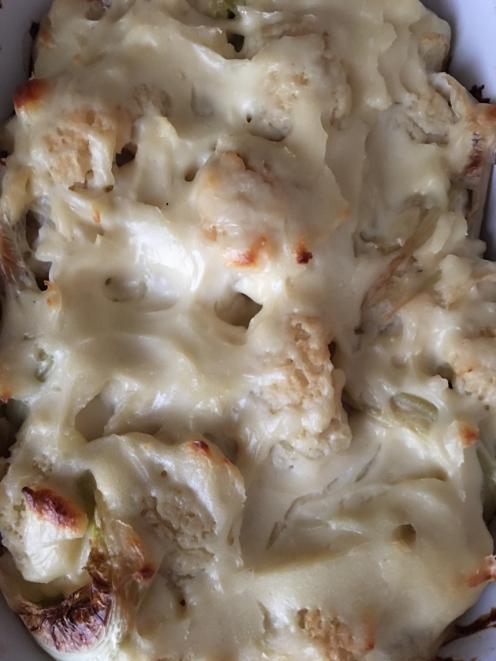
Serves 2 as a main dish or 4 as an accompaniment
1 whole head of smoked garlic
1 medium cauliflower
1 litre full-cream milk
70g butter
70g plain flour
100g mature cheddar
1 finely grated handful of parmesan
1 tsp nigella seeds
Method
Wrap the head of garlic, whole and unpeeled, in tin foil and bake for 40 minutes at 200degC until the skin is golden and the flesh is soft and fragrant.
Break the cauliflower into large florets, discarding the tougher stalks.
Pour the milk into a saucepan and place over a moderate heat. Break the head of garlic into cloves, peel away the flaky skin, then squeeze the soft dark flesh from each clove into the milk. When the milk is hot, but before it boils, remove from the heat and leave it to infuse with the garlic for 20 minutes.
Put a pan of water on to boil and steam the cauliflower over it for 5-7 minutes. (You could boil it if you prefer.)
Set the oven at 200degC.
Melt the butter in a pan then stir in the flour and cook for 5 or 6 minutes, stirring constantly while slowly adding the milk and garlic. You want a smooth sauce that will coat the back of the spoon. Grate the cheddar and stir into the sauce then season with salt and black pepper. Leave over a very low heat to simmer, stirring from time to time (it will burn on the bottom if you don’t).
Drain the cauliflower and place the florets in a huddle in a baking dish. Spoon the sauce over them then scatter with a little grated parmesan and the nigella seeds. Bake for 25-30 minutes or until the sauce is bubbling around the edge of the dish and the cauliflower is lightly toasted.
— Guardian News and Media
Follow Nigel on Twitter @NigelSlater

